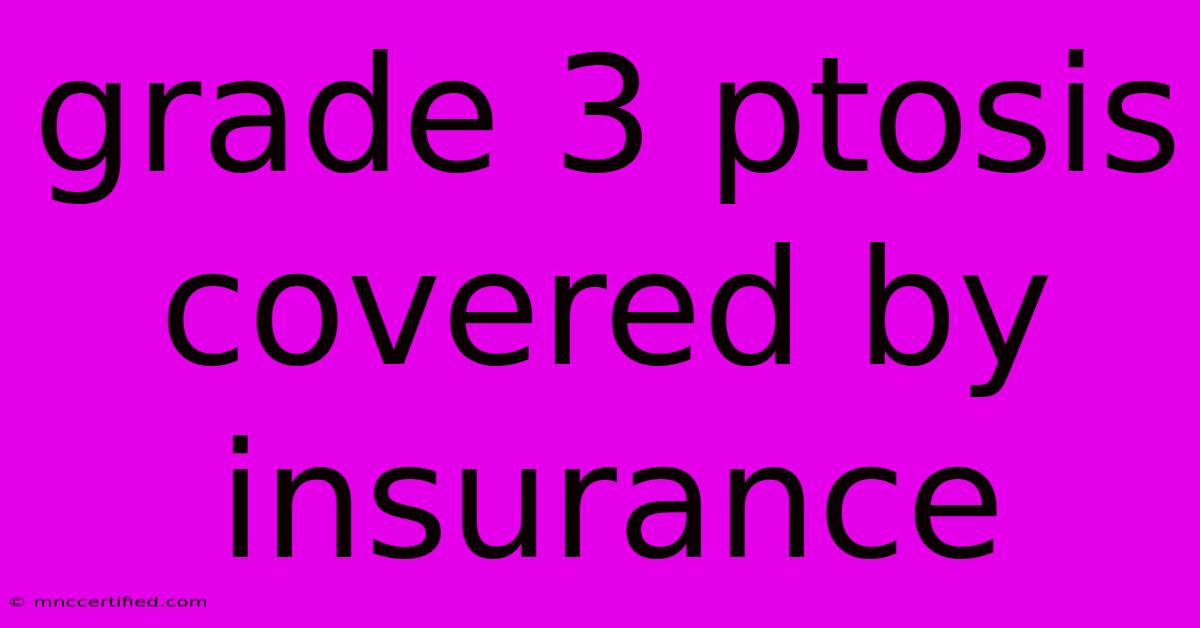Grade 3 Ptosis Covered By Insurance

Table of Contents
Understanding Grade 3 Ptosis and Insurance Coverage
Ptosis, also known as drooping eyelid, can be a frustrating and visually impairing condition. While it can affect people of all ages, it's particularly concerning in children, especially when it's severe, like in Grade 3 ptosis. This article explores the nuances of Grade 3 ptosis and how insurance coverage might apply to its treatment.
What is Grade 3 Ptosis?
Ptosis is graded based on the severity of the eyelid droop. Grade 3 ptosis is characterized by the upper eyelid covering most or all of the pupil. This can significantly affect vision, making it difficult to see clearly and even causing headaches or eye strain.
Reasons for Coverage
Insurance companies often cover procedures addressing conditions that significantly impact a person's quality of life. Grade 3 ptosis typically falls into this category due to its potential for:
- Vision impairment: Difficulty seeing clearly can hinder daily activities, impacting schoolwork, social interactions, and overall well-being.
- Cosmetic concerns: The significant eyelid droop can affect appearance and self-esteem, especially in children.
- Safety risks: Reduced vision can increase the risk of falls or accidents, particularly for active children.
Factors Influencing Coverage
Insurance coverage for ptosis treatment depends on several factors, including:
- Policy specifics: Each insurance plan has its own set of covered procedures and pre-authorization requirements.
- Diagnosis and documentation: A thorough diagnosis from an ophthalmologist or pediatric ophthalmologist is crucial.
- Medical necessity: The doctor must clearly document the impact of ptosis on the child's vision and daily life to justify the medical necessity of treatment.
The Importance of Pre-Authorization
Before undergoing any ptosis surgery, always contact your insurance provider to understand:
- Covered procedures: What types of ptosis surgery are covered under your plan?
- Pre-authorization requirements: What documentation needs to be submitted for approval?
- Co-pays and deductibles: What are the out-of-pocket costs associated with the surgery?
Finding Solutions and Advocacy
Navigating insurance coverage for Grade 3 ptosis can be complex. It's vital to:
- Work closely with your child's doctor: They can provide accurate diagnoses, documentation, and communication with insurance providers.
- Contact your insurance company early: Don't wait until the last minute. Getting pre-authorization can be time-consuming.
- Advocate for your child: Understand your rights and policies. Don't hesitate to appeal denials or seek support from patient advocacy groups.
Conclusion
While insurance coverage for Grade 3 ptosis can vary, understanding your policy and actively engaging with your provider can help ensure that your child receives the necessary treatment to improve their vision, safety, and well-being.

Thank you for visiting our website wich cover about Grade 3 Ptosis Covered By Insurance. We hope the information provided has been useful to you. Feel free to contact us if you have any questions or need further assistance. See you next time and dont miss to bookmark.
Featured Posts
-
Ketamine Therapy Insurance Coverage
Nov 14, 2024
-
Illinois Investment Banking Academy
Nov 14, 2024
-
Dogecoin Jumps On Trumps Latest Announcement
Nov 14, 2024
-
Trump Taps Gaetz For Attorney General
Nov 14, 2024
-
India Beats South Africa In Third T20 Match
Nov 14, 2024